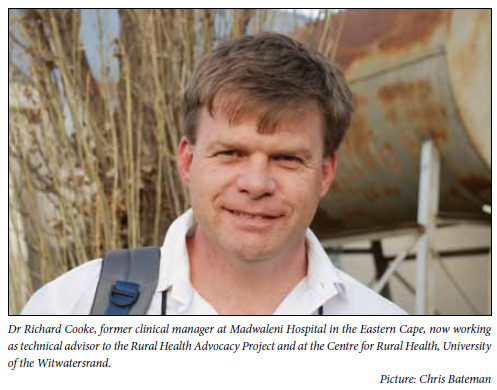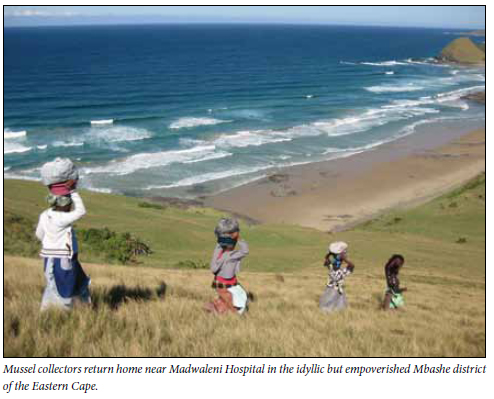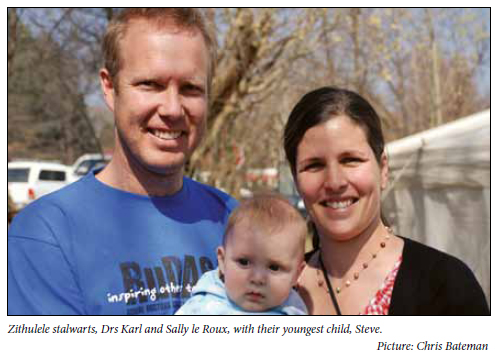Serviços Personalizados
Artigo
Indicadores
Links relacionados
-
 Citado por Google
Citado por Google -
 Similares em Google
Similares em Google
Compartilhar
SAMJ: South African Medical Journal
versão On-line ISSN 2078-5135
versão impressa ISSN 0256-9574
SAMJ, S. Afr. med. j. vol.101 no.11 Pretoria Nov. 2011
IZINDABA
Caring for doctors is caring for the community - RuDASA

Take two dedicated, efficient doctor/ managers out of the mix at a deep rural district hospital and the local health care system begins to implode, leaving a nursing manager scrambling to re-assign remaining staff while the local population is left with the prospect of little more than a mediocre day hospital.
The story of the 180-bed Madwaleni Hospital in the Mbashe sub-district (with a population of 262 000, and rated the eighth most deprived sub-district in the country) of Amathole on the north Eastern Cape coast, with its 33 attendant clinics, is a cautionary tale which sadly epitomises so much of South Africa's human resources health crisis.
That an entire community's health needs can turn on the personal life of a single clinical manager (who left in February last year to marry a woman in Johannesburg, where he was promptly offered a top multi-facetted academic post), portrays the historical neglect of the country's health care staffing. Dr Richard Cooke, recipient of two Discovery Foundation awards (Family Medicine in 2007 and Rural Health Care last year) told colleagues at the 15th annual Rural Doctors Association of Southern Africa (RuDASA) conference that he nearly 'burst into tears' at the prospect of several health care programmes he had initiated during his six-year Madwaleni tenure 'falling flat' and jeopardising the health of so many. Shortly before he left Madwaleni, his close ally, a local resident and the hospital manager, one Matron Vinjwa (who was past retirement age), resigned. Cooke's departure reduced the doctor complement to 9 (foreign qualified doctors and community service medical officers, but without leadership). He could not bring himself to watch 'from afar' as all the programmes he had initiated started slipping.
So he returned for 6 months last year to help out, steering the hospital through a debilitating nursing strike during which he and the stand-in hospital manager, Dr Sonjezo Conjwa, additionally swept floors and fed patients. By December last year, when Cooke left for the second time, his stand-in colleague had had enough. His replacement was absent from duty for long periods and the person responsible for overseeing his performance, the district manager, blissfully unaware. Upon hearing of this, the province's Director-General, Dr Siva 'The Axeman' Pillay, promptly removed both, having already suspended the hospital's admin manager for alleged financial irregularities and its human resources manager a year earlier (because both appealed their suspensions, their posts have not been filled). Pillay kicked his department's recruitment engine into top gear but at the time of going to press, the appeal process was still underway. (Pillay is constantly besting his own national record for firing, removing or suspending crooked, inept or dysfunctional provincial staff since he took the post in April last year - now at 830 and counting).1
Domino effect when competence takes flight
Cooke told the RuDASA conference that all the remaining Madwaleni doctors were due to leave at the end of this year, because of absent and inadequate management and leadership, the only constant being a much admired, stalwart nursing manager, Mrs Thembekile Pencil (who has done the jobs of four people, her own and managing the hospital, clinical and administrative posts as circumstances demanded). Pillay confirmed that replacements were being urgently sought while the hospital was centrally managed. He urged doctors at the RuDASA conference to become familiar with the relevant regulatory framework, so that if they were unhappy with their immediate superior they could use alternative options. 'If managers are hopeless, people leave. This [issue] is beyond training for managers ... Madwaleni is an excellent example of what can happen,' he said.
Cooke, a family physician, now works as the technical advisor to the Rural Health Advocacy Project and at the Centre for Rural Health, University of the Witwatersrand, where he lectures clinical associates, undergraduates and family medicine registrars. In an interview with Izindaba he, along with several other rural veterans, urged the legal ratification of communityoriented primary health care (COPHC) in the National Health Act. The grassroots district health council (as well as hospital boards and clinic committees) upon which the entire COPHC system is built (feeding into the central national consultative health forum), has yet to be given legal and operational 'teeth' in terms of the National Health Act. This has dire implications for the much-vaunted re-engineering of the health system where interventions are based on the disease profile and burden in each community, whose structures help outline the core of any successful approach. Cooke said it was 'ironic' that the COPHC approach was first introduced by Drs Sydney and Emily Kark at Pholela, KwaZulu-Natal, well before the National Party came to power in 1948, but suffered from a subsequent terminal lack of political support. Their highly successful system was taken up in Cuba where it thrived, creating some of the world's best cost-benefit health care outcomes, which South Africa was now belatedly drawing on to train its own doctors in that country.
'Unless we can ensure community ownership, this primary health care re-engineering cannot work properly,' he warned.
Scrap Cuban programme - train cheaper and better locally
In a statement released shortly after the RuDASA conference, the Junior Doctors' Association of South Africa (JuDASA) called for the abolition of the costly Cuban training programme, saying the money spent on putting one South African student through the Cuban system could be used to fund three medical students within a shorter period of time in South Africa. It said the National Health Insurance Green Paper recognised the 'disturbing scarcity' of doctors in outskirt hospitals and the attendant poor health outcomes. However, seeking to remedy the situation by merely creating principal specialist posts within the district health system and then expecting doctors from cities to 'suddenly move by osmosis to occupy these posts', seemed simplistic and fruitless. Challenges of rural under-development such as poor road infrastructure, under-developed educational facilities, non-existent recreational facilities and poor telecommunications made it difficult for doctors of any level of training to remain in a rural environment.


'This is in addition to the nightmare of poor working conditions ... Madwaleni Hospital in the Eastern Cape and Kgapane Hospital in Limpopo are classic examples, both characterised by gross mismanagement, poorly maintained physical infrastructure, ancient and broken medical equipment and routine scarcity of essential medicines. Sick patients find themselves travelling on footpaths over cliffs and dongas to get to their under-resourced and dysfunctional hospitals which can hardly deliver basic health services to them,' it added.
The statement, issued in the name of JuDASA's new chairperson, Dr Tende Makofane, said the NHI could never be administered by the current 'mediocre managers' in the public service. It added wryly: 'A box of Panado may not mind the environment it is placed in, but a conscious doctor with social responsibilities may upset all plans to fill up available posts in the smaller district hospitals if the work and social environment remain unaccommodating to their needs and those of their family.'
Chris Bateman
chrisb@hmpg.co.za
1. Bateman C. E Cape chief hits back at 'jobs for pals' charges. S Afr Med J 2011;101:612. [ Links ]














